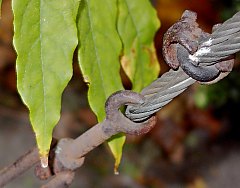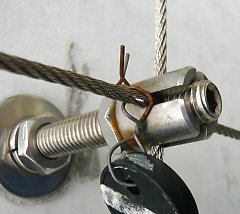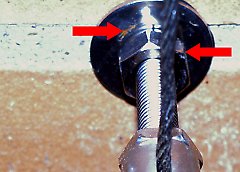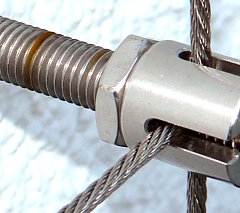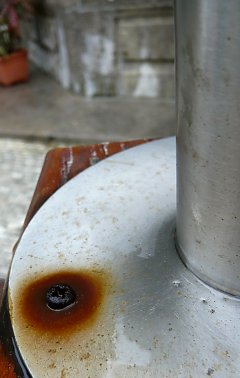Stainless Steel - Properties, Selection, and Rust
All climbing aids (trellises) from FassadenGrün comply with the standard "Stainless Steel -- Rust-Free" for outdoor use. This is not self-evident, as you will learn here. Nevertheless, rust can occur even with stainless steel, and we'll address that in this section; in some cases, we recommend using only the "Premium" Medium Kit or Massive Kit that meet the standard "A4" or "V4A" (AISI 316). Read on to learn more.
Stainless Steel from FassadenGrün
For climbing supports, FrassadenGrün selects grades of stainless steel that are approved for outdoor use in the construction industry in Germany. This means that under normal conditions, these types of steel are sufficiently corrosion resistant and do not exhibit embrittlement or material fatigue, even in frost. Usually, these are steels of the material groups AS (1.4301) and A4 (1.4401 and 1.4404), at least A2, or (in the case of other than DIN-label) materials of equal value. Stainless steel cable, as well as the corresponding U-clamps, are sold only in the high quality A4. Our medium kit "premium" and massive kits provide the high standard V4A.
Disadvantages of Stainless Steel V2A and V4A (AISI 304 and 316)
The Nirosta (non-rust) steels A2 (V2A) and A4 (V4A) used by FassadenGrün are extremely hard and therefore difficult to work or cut. That is, tools might wear out or need to be changed in the process of milling the grooves for the cable cross mounts, for instance. The process is also only possible on particularly heavy, vibration-resistant machines, resulting in a higher price mark.
Dangers Associated with Stainless Steel 1.4305 (A1, or V1A)
Some suppliers use lower quality steel which is easier to work with and less expensive (a type of stainless steel for mounts which can be machined without high tool attrition): AISI 303 (1.4305). According to the Thyssen-Krupp and DEW check list on the use of this material (referred to there as "Nirocut"), this kind of steel is approved only for "decorative parts," (on account of "cases of damage/injury")-- not for tensile and pressure-loaded elements in outdoor applications. It embrittles at temperatures below 0°C and has a higher risk of breakage. This particularly applies to heavily loaded head bars of cable cross mounts. This type of stainless steel does not reach the corrosion resistance of A2. This is why FassadenGrün does not supply parts made of this type of stainless steel, despite possible savings.
Stainless Steel and Magnetism
Stainless steel parts can be both magnetic and non-magnetic! We once received a complaint about eyebolts with the claim that they must not be made of stainless steel because of their magnetism. The research revealed: stainless steel is not magnetic, because the usual heat treatments in the steelworks (stress relief 'annealing') eliminate the magnetic properties in the wires, rods, or bars. But, as a result of some further processing, accompanied by micro-structural change of the stainless steel (tightening, thread rolling, bending, etc..), "strain hardening" might occur and therewith the recurrence of magnetic properties. These have no effect on corrosion resistance.
When to Use V4A / AISI 316?
Why are there even more expensive types, like A4, in addition to the "normal" stainless steel A2? The metalworker's adage is: "A2 does not rust, but A4 doesn't rust at all." As striking as this statement sounds, the stainless steel type A4 is not really necessary! In the case of climbing aids/trellises, it becomes apparent that the material quality A2 is sufficient in about 98% of cases in the private sector and in facade greening. In the exceptional problem cases mentioned below, however, discolouration and, in extreme cases rust, pitting, etc.. are possible with A2, which is why the medium kit "premium" or massive kits are often the best choice. This ensures functionality and a lustrous appearance even under extreme conditions.
Problem Case 01: Salt
As coastal residents know, even stainless steel can rust. Saline air in coastal regions can cause salt deposits that accelerate the oxidation of steel and the development of rust. In this case, A4 must be used and trellises systems should be cleaned 2-3 times a year to remove salt deposits-- by hosing/spraying with fresh (non-saline) water. Rainwater will also clean the trellis if it is exposed to it. (So, even a missing roof overhang which could provide a regular rainwater 'shower' is advantageous.)
Problem Case 02: Exhaust Gases
Exhaust gas in the air in industrial areas and along heavily traveled traffic routes (causing "acid rain") might also lead to discolourations and rust. The description in problem case 01 applies to these cases as well.
Problem Case 03: Flash Rust
Flash rust (rust that occurs quickly-- even overnight) often arises from abrasion of ordinary steel, whereby the tiny particles rust instantly in humid air, precipitate on stainless steel as rust germs, and like a catalyst, produce discolouration, pitting, and surface corrosion. Ferric (iron) abrasion occurs mainly on railway tracks, especially at railway stations, shunting tracks/sidings, etc.. and by heavily travelled streets, wherever brakes are applied and cars are started and a lot of iron is "rubbed off." The use of decorative "precious" rust in architecture and facade design, in trellises in the garden, etc.. can also cause flash rust. Metalworking (grinding, filing, flexing, etc..) is also problematic, as abraded ('rubbed off') iron is then scattered through the air. Even when cutting wire rope from stainless steel, the flying, glowing particles can lose their rust resistance and then act as rust germs! This is so in the previous problem case- 01.
Problem Case 04: Contaminated Splash Water
Water splashes may also contain iron salts. If these get on stainless steel, they can lead to rust, both on smooth surfaces and in the capillaries of threads. Acidic and ferrous detergents and fertilisers, and possibly also de-icing salts, are problematic. Water already containing dissolved rust is especially critical. A single rusting screw used somewhere in the upper area of a trellis system can be devasatating if it dumps its rust 'cargo' into rain- or condensation water and distributes it to the climbing system below via a dripping corner or edge. Again, what is described in problem case 01 applies.
Problem Case 05: Using Different Metals Together
Under no circumstances should stainless steel components (e.g. FassadenGrün crossheads) be used together with inferior low-grade parts or materials (for example, galvanised wires and galvanised threaded rods), as this leads to contact corrosion. It is also important that only high-grade open-ended wrenches and pliers (marked "Chrome-Vanadium") are used for assembly, in order not to "rub" off any low-grade iron, which can lead to discolouration and rust later on. Binding material containing iron wire is corrosive as well, and should be totally avoided.
Remedy for Rust
When rust occurs, you can usually assume that it was caused by a one-time action. The rusted parts can then be treated with a standard commercial stainless steel cleaner to dissolve and wash away impurities and flash rust particles.
In the case of advanced corrosion, the surface must be worked thoroughly. Simply brushing with a brass- or stainless steel wire brush (or steel wool) is not enough. Between two cleansings, the affected areas must be polished with the help of 2 - 3 kinds of sandpaper, starting with a 120 or 240 grit, finishing with a 600 or 1200 grit. To reach into the (thread) furrows, simply crease the sandpaper. Please contact us if you need assistance; we can provide the necessary cleaning utensils.
If this is not successful in the long term, the mounts need to be replaced with A4 anchors (so,
, or WM 12153). And naturally, it is best to determine the cause of the rust to protect against further contamination.
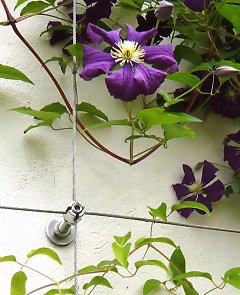
Stainless steel wire rope trellis for clematis
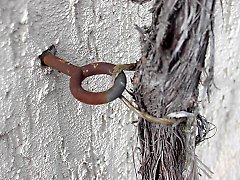
Due to increased contact with the electrolytes from washed out plant substances and slower drying, galvanised eyebolts on trellises corrode even faster than they otherwise would on outdoor applications.
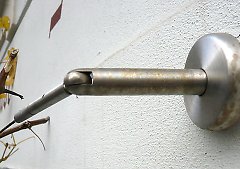
With low-grade stainless steels not intended for outdoor use, discolouration often develops on larger areas shortly after mounting.
Combining "Stainless Steel" and "Galvanised" Materials
Stainless steel wire ropes and trellises require stainless steel mounts. If inferior galvanised (zinc-coated) steel mounts are used, there will likely be corrosion and rust problems at the contact areas sooner or later. Even a tiny galvanised screw in a large, high grade, steel support or beam (see photo) will cause massive corrosion/rust formation that immediately spreads over to the high grade stainless steel system!
The opposite is, in some cases, possible: small stainless steel componenets can be used within a greater galvanised system without leading to electrolytic corrosion. For example, Fassadengrün's high grade stainless steel mounts and fittings can be paired with existing galvanised trellises or wire rope systems; this works because the mass (and "potential") of the inferior metal is significantly greater than that of the high grade metal. Another possibility is to lay a thin stainless steel wire rope through a massive galvanised supporting mount (high "potential")-- no rust problem. Another example is the famous tiny, high grade, steel screw in the huge, galvanised support-- also here nothing will rust.

